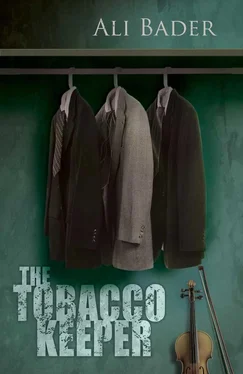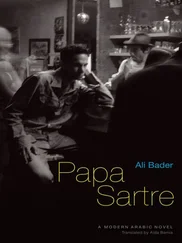On the final day of his first week in Tehran, Haidar Salman went to look for Ismail al-Tabtabaei’s house, hoping that he might have returned from Baghdad. After asking several people on the street, he managed to locate the house in the aristocratic neighbourhood to the north of Pahlavi Street. He visited it one evening carrying his suitcase, violin, umbrella, hat and black gloves.
The house, hidden by thick trees, was totally isolated.
He stopped in front of the house and knocked on the brass knocker in the middle of the grand door. After a few moments a maid opened the door, wearing a red pinafore over her beautiful clothes. No sooner had he started speaking to her in English than Ismail al-Tabtabaei came out in person to greet him. He was a handsome, tall, grey-haired, fifty-year-old man in an elegant outfit. He took Haidar straight to a small room upstairs. The room was decorated with strange old drawings and its furniture was faded with age. It was to be his room.
The mere fact of entering the house represented a huge turning point, not only in his whole life but also in his second personality as the protected man, although it was not protected by the first character as in Pessoa’s Tobacco Shop . Haidar Salman became in fact the protégé of the great merchant. From the moment they first met, they both realized that their relationship would go way beyond the simple assistance offered by the trader to supporters of the left. Did not the protected man in Tobacco Shop also believe in the workings of fate and destiny?
The following morning, when Haidar Salman discovered that Ismail al-Tabtabaei had a sick daughter called Tahira, his conviction grew stronger that his presence in that house was an act of providence. The father spent most of his evenings sitting beside his daughter’s bed.
During the early days of his stay, Haidar Salman spent most of his time in his room. He was always extremely shy, reluctant and uncomfortable with the aristocratic lifestyle. He was daunted by the oppressive stillness and opulence of his host’s house. He therefore preferred to spend his evenings sitting alone in his room, dreaming of music. He confined his passion for music to his wild dreams, and in the morning would explore Tehran’s sidestreets, crowded with workers, voices and passers-by. When he returned at noon, the sun would be high above the windows of the house and, after lunch, its golden beams would fill the dining room and hall where Haidar would sit for many hours with Ismail al-Tabtabaei and his daughter Tahira.
Everybody stayed in the sunny hall during the winter. Tahira sat with her pale, withered, beautiful face and her golden hair falling down over her shoulders, while Ismail stayed at her beck and call, his gaze unbroken. Haidar Salman looked down shyly and kept quiet. He seemed to be listening to the noises coming through the window, to the vague sounds of winter that kindled his imagination. It was a mysterious space filled with the scent of trees and melting snow. But a dreary atmosphere gradually infiltrated the room. One evening, when Haidar Salman came home late, exhausted from having walked the length of Reza Pahlavi Street, an idea suddenly hit him. He decided to dedicate an hour each day to playing music to the pale, sick girl who was lying in bed and to her poor father who always stayed by her side.
He had no idea how much his short pieces would raise the spirits of the young woman and make her so much more jovial and optimistic. The father became very attached to him, for the young man not only played the violin for the lovely girl, but took her on outings during the day, particularly after she began to feel much better. Instead of the painful headaches she used to suffer from, she had a sensation akin to an ecstatic dizziness, a feeling closer to passionate love than to illness. Tahira was exceptionally sensitive and highly impressionable. She received the young man into her father’s house with a mixture of profound sadness and joy. When she stood in front of him, the muscles of her face twitched painfully and her eyes filled with tears, for she was burning with love. She came to realize that she was desperately attached to him and could never let him go. Although he reciprocated her thoughts and feelings and continued to treat her with a great deal of tenderness, he tried hard to avoid falling hopelessly in love with her.
[ In a letter to Farida, Haidar Salman expressed his wish to release Farida of her bond to him so that she might be free to remarry. Three days later, he sent her a long letter telling her about his new life with Tahira, who was, he said, his last chance to get back to Baghdad. Although he wasn’t completely happy, he enjoyed his strolls along Tehran’s wide boulevards and his visits to breathtaking parks where ancient cypress trees had provided shade and exuded fragrance since the times of the Qajars. He also admired the magnificent mansions with their large grounds and coloured windows. In another letter, he told Farida about his visits to the most important sights of Tehran, such as the Caravanserai market with its passages and low rows of domes. With Tahira he also visited the peaks of the snow-capped Kallus Mountain and the beautiful resort of Kelardasht and together they swam in hot springs at the coastal resort of Ramsar. They toured the monuments of ancient Masule, strolled through the markets along the Caspian Sea, and visited Persepolis and the inscription at Naqshe Rostam. Then they stood in front of Hafez’s grave, its dome rising high as a symbol of the soul soaring up to heaven .]
The intimacy between Haidar and Tahira was at its strongest during this period. They would spend whole mornings hanging out on Tehran’s streets, either strolling on foot or cruising in Tahira’s car. The time they spent together allowed Ismail al-Tabtabaei to turn his attention again to his business, instead of being the constant companion of his daughter. Haidar therefore became important not only for the daughter but also for the father’s business. As far as Tahira and Haidar were concerned, their outings represented almost a sacred ritual. They would start their walks from north of Reza Pahlavi Street, with its congested traffic, cars and motorcycles. They would then move on to the middle section of the street where the statue of the sage, Al-Firdawsi, the writer of the epic Shahnameh, stood. They would walk in front of the great gate to Tehran University which was designed by the French architect Godard as an extension of the Dar al-Funun, itself established by the first Iranian reformer of the nineteenth century, Mirza Taqi Khan Amir Kabir, in an attempt to import Western science into Iran. They would also go to the Talar-e Rudaki theatre, which was built in the shape of a tulip and named after the Persian poet Abu Abdullah Jafar Rudaki of the fourth century of the Hijra calendar.
It was at this theatre that Haidar Salman gave a concert a year after his marriage to Tahira, thanks to the good offices of the influential merchant Ismail al-Tabtabaei. Haidar gave a solo performance of Henri Vieuxtemps’ Opus 4 in D Minor, which he played with absolute brilliance, precise phrasing, soaring melody and unparalleled genius, earning him the admiration of Tehran’s upper echelons and the approbation of the aristocratic families who attended the concert.
Haidar Salman wrote several letters to Farida at this time, telling her of his adventures and his exploration of that beautiful city. Tahira was his constant companion on these trips. His letters overflowed with a marked fascination with mosque architecture, sparkling blue domes and gilded minarets. He was captivated by silver and wooden decorative patterns and mirror-encrusted ceilings, which were also found in wealthy homes. But the question that perplexed me was whether Haidar Salman became a true Muslim in his heart. Or was he just a Ricardo Reis, who believed in Greek gods despite living in Christian Europe? It was certain that Tahira was filled with instinctive religious faith and wholehearted acceptance of Shia rituals. But was his own complete identification with the persona of Haidar Salman motivated by religion or by art? He later made countless comparisons between elevated art, on the one hand, and the visual and graphic vulgarity of politico-religious propaganda, based on total superficiality and crudity, on the other.
Читать дальше












